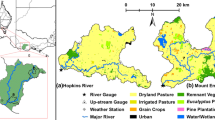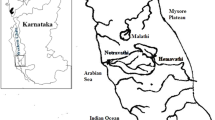Abstract
Climate change, drought and the world’s growing population are increasing the demand for water which in turn requires improved water resources management. The sustainable management of a watershed requires a thorough knowledge of its water resources, including monthly streamflow. Spain is home to a large number of ungauged watersheds, the streamflows of which are often unknown. Chavez et al. (2007) reported a model for predicting monthly streamflow in ungauged watersheds that was validated for use in areas of tropical climate in Central America and a dry area in South America. This work reports an attempt to assess the performance of this model for eventual use with ungauged watersheds in Spain, using data for a number of watersheds for which gauging data were available. The proposed model took into account physical characteristics such us the soil infiltration rate, the slope of the terrain, plant fractional cover, the monthly moisture adequacy index, and the leaf area index. Comparisons of model-predicted monthly streamflows and those actually measured showed the Chavez et al. model unable to make reliable predictions for Spanish watersheds in its current form. A new approach has been developed considering only smaller watersheds in Spanish conditions, changing parameters in the original model. These parameters have been calibrated and validated, reaching adequate adjustment of results.



Similar content being viewed by others
References
Allen R, Pereira L, Raes D, Smith M (1998) Crop Evapotranspiration (guideline for computing crop water requirements). Irrigation and Drainage Paper No 56. Food and Agriculture Organization (FAO). Rome, Italy
Baigorria GA, Jones JW, O’Brien JJ (2007) Understanding rainfall spatial variability in southeast USA at different timescales. Int J Climatol 27(6):749–760
Brouwer C, Prins K, Kay M, Heibloem M (1988) Irrigation Water Management: Irrigation Methods. Training Manual No 5. Food and Agriculture Organization of the United Nations (FAO). ftp://ftp.fao.org/agl/aglw/fwm/Manual5.pdf (March 7, 2012)
BSEDEM (1996) Mapa preliminar de Erosión de suelos—región árida, semiárida y subhumeda seca de Bolivia. Natural Resources Sub-Secretary, Land Conservation Department. Bolivian Sustainable and Environmental Development Ministry.
Chavez JL (1999) Water resource potential of the Rio-Grande river basin in Bolivia. MS Report. Biological and Irrigation Engineering Department. Utah State University. Logan, UT
Chavez JL, Gowda PH, Griffin R, Rivera S, Neale CMU (2007) A simple empirical stream flow prediction model for ungauged watersheds. Proc. ASABE Annual International Meeting, Minnesota. 072003
Dal-Ré R, Ayuga F (1989) New method to determinate monthly runoff in small basins. In: Dodd, Grace (eds) Agricultural engineering, land and water use. Balkema, Rotterdam, pp 481–486
Davis T (2003) Thirsty Crops: Agricultural Water Use and River Basin Conservation. Adapted from Water Use for Agriculture in Priority River Basins, Rob de Nooy. WWF’s Living Waters Program—Conserving the source of life. World Wide Foundation, http://assets.panda.org/downloads/agwaterusefinalreport.pdf (March 7, 2012)
Deckers DLEH, Booij MJ, Rientjes THM, Krol MS (2010) Catchment variability and parameter estimation in multi-objective regionalisation of a rainfall–runoff model. Water Resour Manag 24(14):3961–3985
Duncan DB (1955) Multiple range and multiple F tests. Biometrics 11(1):1–42
EEA (2010) CORINE Land Cover Project. European Environment Agency. http://www.eea.europa.eu/data-and-maps/data/corine-land-cover-2000-clc2000-seamless-vector-database (March 7, 2012)
Fang X, Thompson DB, Cleveland TG, Pradhan P, Malla R (2008) Time of concentration estimated using watershed parameters determined by automated and manual methods. J Irrig Drain E-ASCE 134(2):202–211
FAO-SDRN Agrometeorology Group (1997) Köppen climate zones. Global climate maps series. FAO Environment and Natural Resources Service (SDRN). Rome, Italy
Ffolkes EA (1980) Interim Report, National Plan for Irrigation and Drainage to year 2033. Honduras, C.A., Canadian Development Agency (CIDA), 127
Fisher RA (1956) Statistical methods and scientific inference. Hafner, NY
Garrick M, Cumane C, Nash JE (1978) A criterion of efficiency for rainfall-runoff models. J Hydrol 36(3–4):375–381
Grubbs F (1969) Procedures for detecting outlying observations in samples. Technometrics 11(1):1–21
Gupta HV, Kling H, Yilmaz K, Martinez GF (2009) Decomposition of the mean squared error and NSE performance criteria: implications for improving hydrological modelling. J Hydrol 377(1–2):80–91
Haktanir T, Sezen N (1990) Suitability of two-parameter gamma and three-parameter beta distributions as synthetic unit hydrographs in Anatolia. Hydrol Sci J 35(2):167–184
Hargreaves GH (1992) Hydrometereologic data for Honduran water resource development. Biological and Irrigation Engineering Department. Utah State University. Logan, UT
Hargreaves GH, Merkley GP (1998) Irrigation Fundamentals: an applied technology text for teaching irrigation at the intermediate level. Water Resources Publication, LLC, Highlands Ranch, p 128
Hargreaves GH, Olsen ER (1999) A water balance study of the Patuca Basin. Proc. Benchmarking Irrigation System Performance using water measurement and water balance Conference, USCID, San Luis Obispo, CA, 233–244.
Hargreaves GH, Chavez JL, Jensen DT (2001) Reconnaissance evaluation of transbasin water transfers. In: Schaak J, SS Anderson (eds) Proc. Water Management Conference, USCID. P. Denver, CO, pp. 393–407
Herbas J (1998) Proyecto Nacional de Riego PRONAR. Bolivian National Irrigation Project Agency, Cochabamaba
Hirt K, Lara G, Hasemann G (1989) Archaeological research in the El Cajon region. University of Pittsburgh and Instituto Hondureño de Antropología. Pittsburgh-Tegucigalpa
IGN (1995) Colección de mapas topográficos. Instituto Geográfico Nacional, Madrid
Johnston K, Hoef JMV, Krivoruchko K, Lucas N (1996) Using ArcGIS geostatistical analysis. ESRI, Inc., NY
Kirpich ZP (1940) Time of concentration in small agricultural watersheds. Civil Eng 10(6):362–370
Kruskal W, Wallis WA (1952) Use of ranks in one-criterion variance analysis. J Am Stat Assoc 47(260):583–621
Kumar V, Remadevi V (2006) Kriging of groundwater levels—a case study. JOSH 6(1):81–94
Le Houerou HN (2004) An agro-climatic classification of arid and semiarid lands in the isoclimatic Mediterranean zones. Arid Land Res Manag 18:301–346
Levene H (1960) Robust tests for equality of variances. In: Ingram Olkin, Harold Hotelling, et al. (eds) Stanford University Press, pp. 278–292
Makhlouf Z, Michel C (1994) A two-parameter monthly water balance model for French watersheds. J Hydrol 162(3–4):299–318
Martínez V, García AI, Ayuga F (2002) Distributed routing techniques developed on GIS for generating synthetic unit hydrographs. T ASAE 45(6):1825–1834
Mouelhi S, Michel C, Perrin C, Andreassian V (2006) Linking stream flow to rainfall at the annual time step: the manabe bucket model revisited. J Hydrol 328(1–2):283–296
Nash JE, Sutcliffe JV (1970) River flow forecasting through conceptual models. Part I: a discussion of principles. J Hydrol 10:282–290
Norman JM, Kustas WP, Humes KS (1995) A Two-Source approach for estimating soil and vegetation energy fluxes in observations of directional radiometric surface temperature. Agric For Meteorol 77:263–293
Rivera S (2005) Testing forestry BMP’s o protect water quality in Honduras. Ph.D. Dissertation. College of Natural Resource, Watershed Science Unit, Utah State University. Logan, UT
Rocha O (1997) Delimitación de Cuencas Hidrográficas en Bolivia. Estrategia de Gestión de Cuencas Hidrográficas. Bolvian Sustainable and Environmental Development Ministry (BSEDEM) and the Food and Agricultural Organization of the United Nations (FAO). Contract FAO/TCP – BOL/6611, La Paz, Bolivia.
Romero-Toro-Gascueña I, Sastre-Merino S, Vicente-Guillén J, Ayuga-Téllez E, García-García MJ, González-García C, Grande-Ortíz MA (2011) Comparison of interpolation methods for the study of forest variables using a Geographic Information System. J Agric Sci Technol B 1(3):428–436
Schaefli B, Gupta HV (2007) Do Nash values have value? Hydrol Process 21:2075–2080
Scurlock JMO, Asner GP, Gower ST (2001) Global Leaf Area Index Data from Field Measurements, 1932–2000. Data set. Available on-line [http://www.daac.ornl.gov] from the Oak Ridge National Laboratory Distributed Active Archive Center, Oak Ridge, Tennessee, U.S.A. (February 14, 2012)
Stefansky W (1972) Rejecting outliers in factorial designs. Technometrics 14(2):469–479
Stigler SM (1989) Francis Galton’s Account of the Invention of Correlation. Stat Sci 4(2):73–79
TRAGSATEC (1994) Restauración Hidrológico Forestal de Cuencas y Control de la erosión. Mundi-Prensa, Madrid (Spain)
Urbano P, Couillaud P, Oyana T, Barona E, Leclerc G, Hoyos R (1998) Honduras Interface version 2.0. (CD-ROM) ed. International Center for Tropical Agriculture (CIAT), GIS
USDA-NRCS (2006) Keys to Soil Taxonomy. Natural Resources Conservation Service, United States Department of Agriculture. Washington, DC. (ftp://ftp-fc.sc.egov.usda.gov/NSSC/Soil_Taxonomy/keys/Spanish_Keys_11th_ed.pdf) (March 7, 2012)
USDA-SCS (1985) SCS National Engineering Handbook Section 4 Hydrology. Soil Conservation Service, United States Department of Agriculture. Washington, DC.
Weissling BP, Xie H, Murray KE (2007) A multitemporal remote sensing approach to parsimonious streamflow modeling in a south-central Texas watershed, USA. Hydrol Earth Syst Sci Discuss 4(1):1–33
Yavuz H, Erdogan S (2012) Spatial analysis of monthly and annual precipitation trends in Turkey. Water Resour Manag 26(3):609–621
Acknowledgments
The authors thank Grupo Tragsa for its support, provided via its funding of the project “Proyecto hidrológico de pequeñas cuencas no aforadas.” We are grateful to Dr. José Carlos Robredo for facilitating the climate data used in this study. In addition, we are thankful to anonymous reviewers who through their comments and suggestions made possible the improvement of the quality of this article.
Author information
Authors and Affiliations
Corresponding author
Rights and permissions
About this article
Cite this article
Vicente-Guillén, J., Ayuga-Telléz, E., Otero, D. et al. Performance of a Monthly Streamflow Prediction Model for Ungauged Watersheds in Spain. Water Resour Manage 26, 3767–3784 (2012). https://doi.org/10.1007/s11269-012-0102-5
Received:
Accepted:
Published:
Issue Date:
DOI: https://doi.org/10.1007/s11269-012-0102-5




